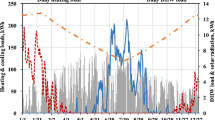Summary
The design of an optimized solar heating system is analyzed based on a new concept which relates degree days as the heat requirement and incoming solar radiation as the heat source. The methodology is exemplified by data from Huntsville, Alabama, for the last two winters 1976/77 and 1977/78. A solar heating system based on an expected incoming solar radiation of 190 Langleys/day would have needed an amount of 27 days supplementary energy but a system designed for an expected value of 140 Langleys/day required only 11 days of additional heat. In the first case most of the supplementary heat must be provided by a carry-over from the previous months while the second system could build up the stored energy during December. An optimized system is a design which strikes a balance between the size of the collector area and the size of storage to result in the minimum cost for the consumer.
Zusammenfassung
Ein neues Konzept für den Entwurf einer optimalen solaren Heizanlage wird vorgeschlagen. Es beruht auf dem Prinzip des Heizgradwertes als Wärmeverbrauch und der Sonnenstrahlung als Wärmequelle. Die Methode wird am Beispiel der letzten zwei Winter in Huntsville, Alabama, demonstriert. Unter der Annahme einer durchschnittlichen Sonnenstrahlung von 190 Langleys/Tag wäre ein Wärmevorrat von 27 Tagen notwendig, der sich für eine Basis von 140 Langleys/Tag auf 11 Tage verringert. Im ersten Falle muß der zusätzliche Wärmeverbrauch bereits zum Beginn des Dezember vorliegen, während er im letzten Fall im Laufe des Dezember angesammelt wird. Eine optimale Heizanlage führt zu einem Minimum der Gesamtkosten für die Kombination der Kollektoren der Sonnenstrahlung und der Wärmespeicheranlage.
Similar content being viewed by others
References
Allred, J. W., Shinn, J. M., Kirby, C. E., Barringer, Sh. R.: An Inexpensive Economical Solar Heating System for Homes. NASA TM X-3294, pp. 56 (1977).
Angell, J. K., Korshover, J.: Variation in Sunshine Duration Over the Contiguous United States Between 1950 and 1972. J. Appl. Meteor.14, 1174–1181 (1975).
Cogley, A. C., Borucki, W. J.: Exponential Approximation for Daily Average Solar Heating or Photolysis. J. Atmosph. Science33, 1347–1356 (1976).
Dickinson, R. E.: Solar Variability and the Lower Atmosphere. Bull. A. Met. Soc.56, 1240–1247 (1975).
Dickson, R. R.: The Relation of Monthly Sunshine Percentage to the 700 mb Height Field. J. Appl. Meteor.16, 482–486 (1977).
Frank, W. M.: Feasibility of Solar Heating in Colorado. In: On Some Environmental Problems in Colorado (Essenwanger, O. M., ed.). Report Depart. of Atmospheric Science, Colorado State University, Fort Collins, pp. 172. 1975.
Gumbel, E. J.: Statistics of Extremes. pp. 375. New York: Columbia University Press 1958.
Halacy, D. S.: Earth, Water, Wind and Sun. pp. 186. New York: Harper and Row 1977.
Hammond, A. L., Metz, W. D.: Solar Energy Research: Making Solar After the Nuclear Model. Science197, 241–244 (1977).
Hoyt, D. V.: Percent of Possible Sunshine and the Total Cloud Cover. Mo. Weather Rev.105, 648–652.
Kusuda, T., Ishii, K.: Hourly Solar Radiation Data for Vertical and Horizontal Surfaces on Average Days in the United States and Canada. NBS Building Science Series 96, US Department of Commerce, pp. 405, 1977.
Reiter, E. R., Johnson, G. R., Somervell, W. L., Jr., Sparling, E. W., Dreiseitl, E., MacDonald, B. C., McQuirk, J. P., Starr, A. M.: The Effects of Atmospheric Variability on Energy Utilization and Conservation. Environmental Res. Papers, No. 5, Colorado State University, CSU C00-1340-55, pp. 72, 1976.
Reiter, E. R., Johnson, G. R., MacDonald, B. C., Somervell, W. L., Jr., Starr, A. M.: The Effects of Atmospheric Variability on Energy Utilization and Conservation. Techn. Proj. Report, EY-76-S-02-1340, Colorado State University, Report C00-1340-55, pp. 48, 1977.
Task Force Report, 1977. Solar Energy, Supt. Documents, November 1974, pp. 543.
Author information
Authors and Affiliations
Additional information
With 3 Figures
Rights and permissions
About this article
Cite this article
Essenwanger, O.M. On the concept of an optimum design for solar heating exemplified by the winter 1976/77 and 1977/78 at Huntsville, Alabama. Arch. Met. Geoph. Biokl. B. 26, 153–169 (1978). https://doi.org/10.1007/BF02242669
Received:
Issue Date:
DOI: https://doi.org/10.1007/BF02242669




